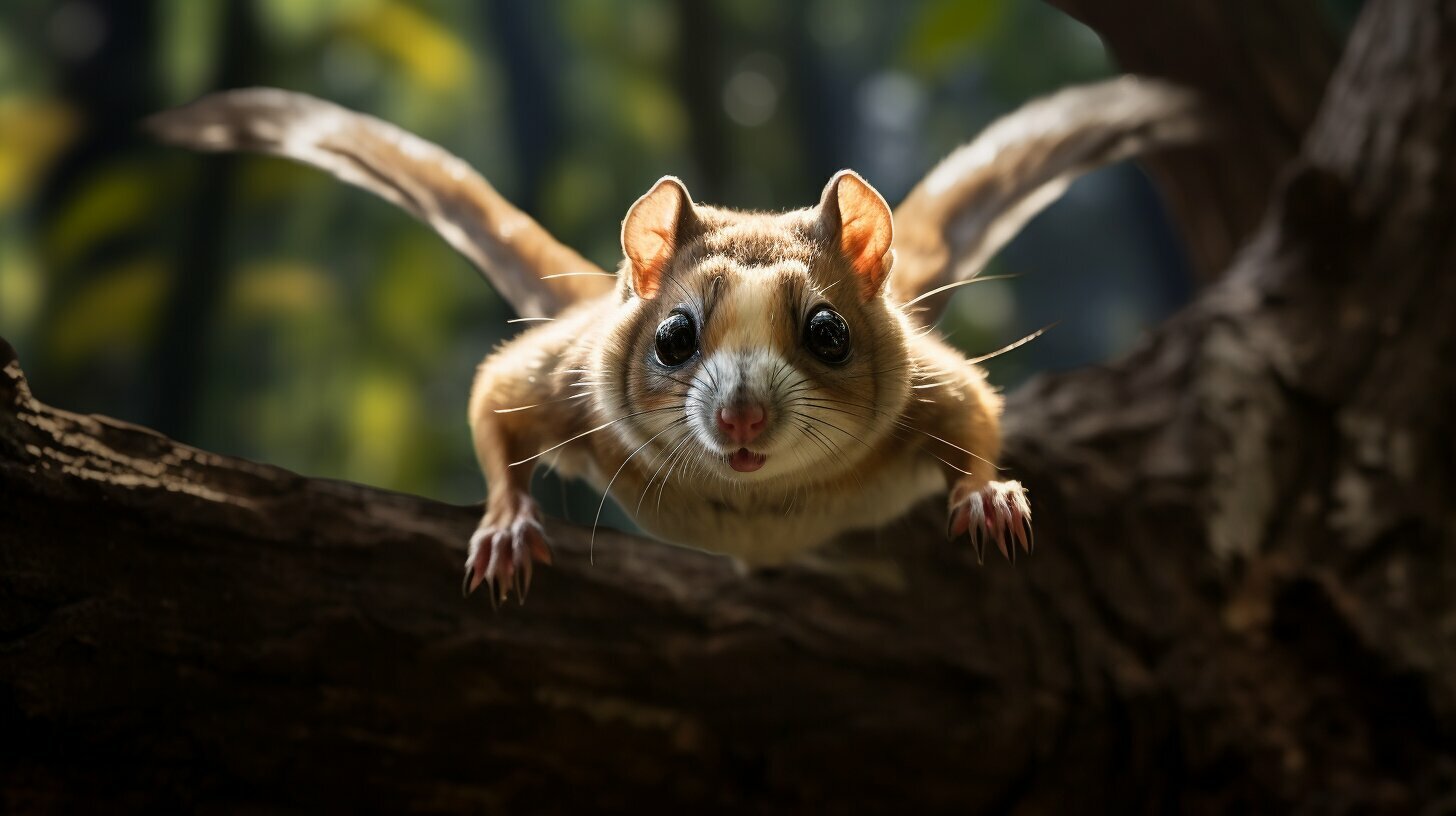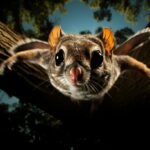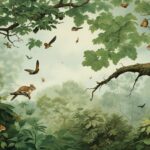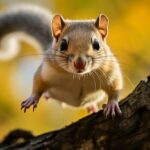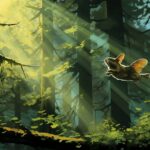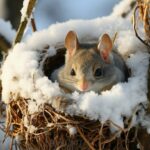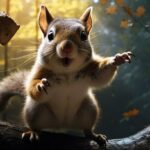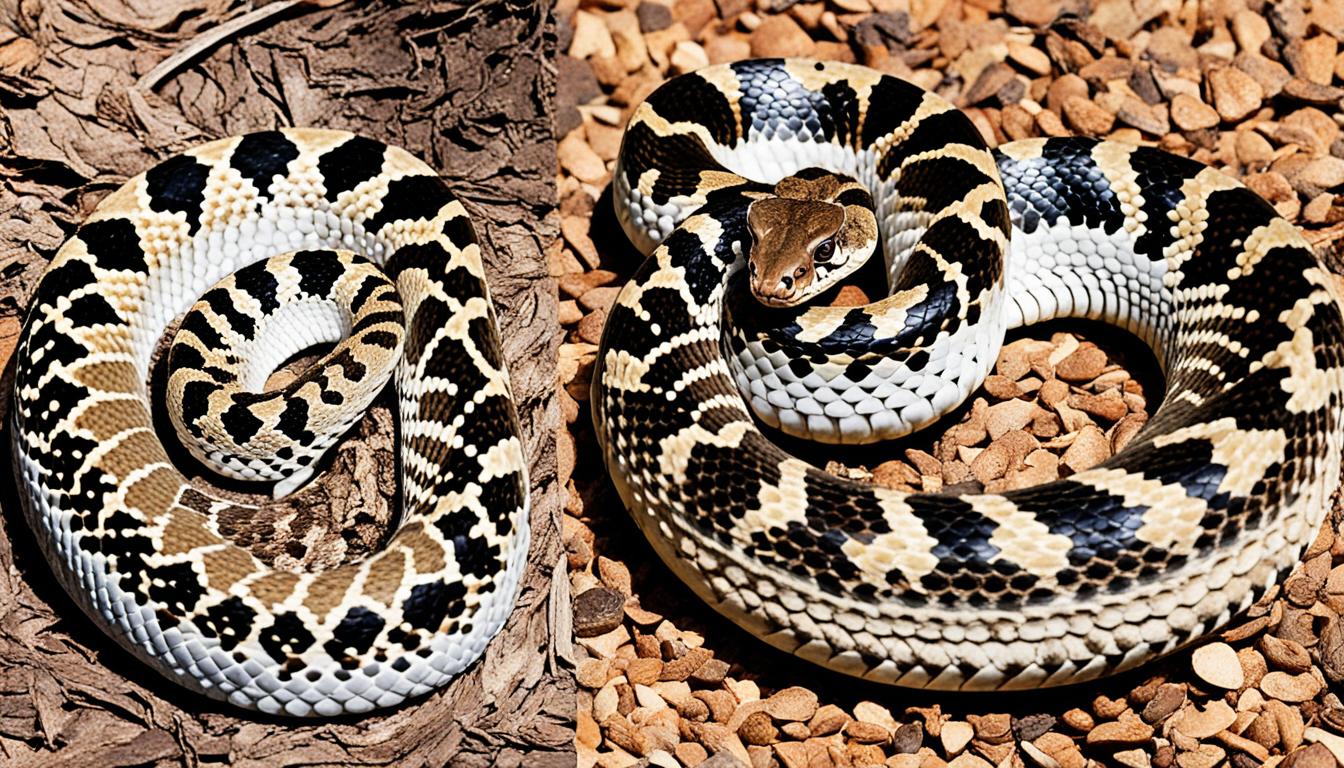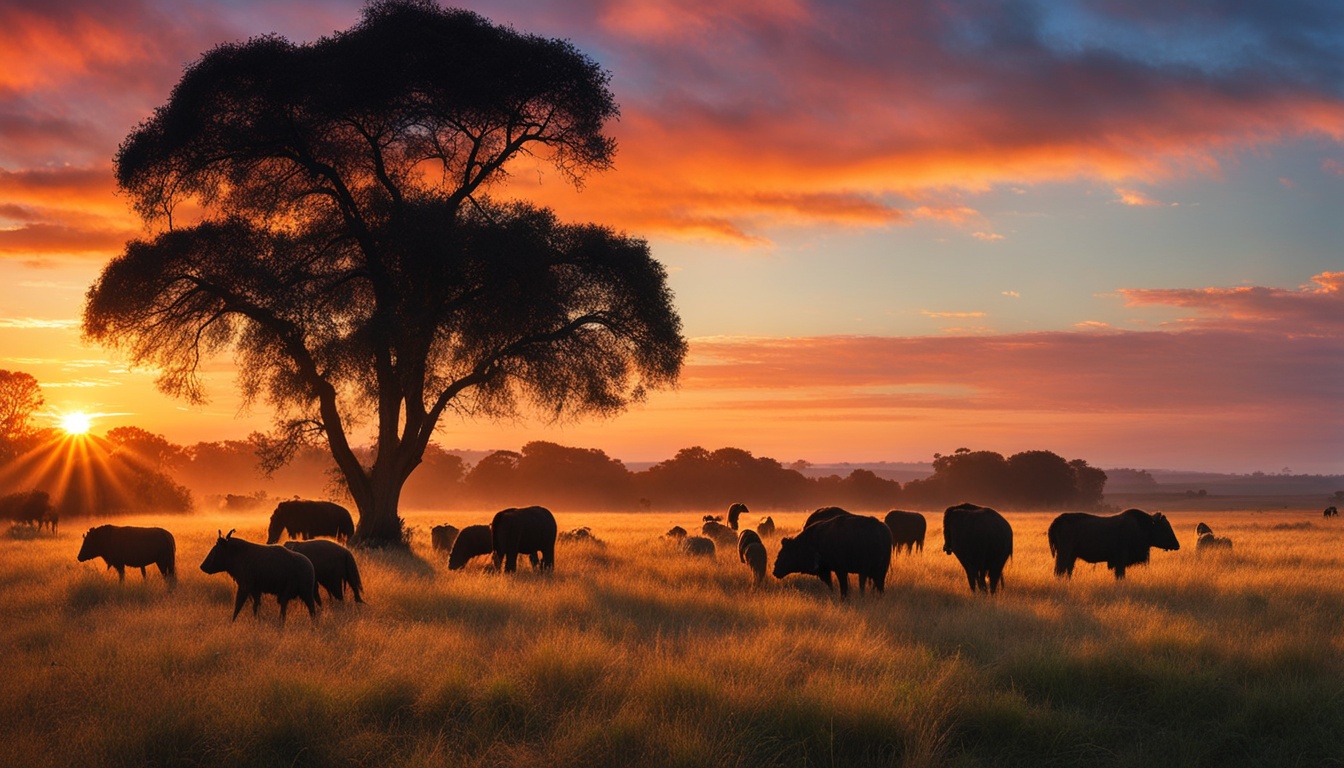Flying squirrel species are fascinating creatures with unique abilities and characteristics. Known for their gliding abilities, these squirrels have captured the curiosity of nature enthusiasts and scientists alike. With their membranous wings, flying squirrels can glide through the air between trees, making them a truly remarkable sight.
In North America, there are two native species of flying squirrels: the northern flying squirrel and the southern flying squirrel. These species inhabit different regions and have their own distinct traits. They are nocturnal creatures that thrive in deciduous and coniferous forests as well as woodlands. Flying squirrels make their homes in various places, including snags, woodpecker holes, nest boxes, and abandoned nests.
As omnivores, flying squirrels have a diverse diet. They consume a variety of foods such as seeds, nuts, fungi, fruit, and insects. The southern flying squirrel is particularly known for its carnivorous tendencies as it occasionally supplements its diet with eggs, birds, and carrion.
During mating season, flying squirrels mate once or twice a year. The mothers play a crucial role in caring for their young, providing them with nourishment and protection for approximately two months.
Unfortunately, some species of flying squirrels are endangered due to the loss of their natural habitats. Human activities, such as deforestation, have had a significant impact on their populations. Nonetheless, humans have also been inspired by the flying squirrel’s gliding abilities. This fascination has led to the development of wingsuit technology, benefiting Base jumpers and skydivers in their thrilling pursuits.
In conclusion, flying squirrel species offer a glimpse into the diverse and captivating world of nature. With their unique adaptations and behaviors, they truly stand out as remarkable creatures. It is essential that we recognize their importance and work towards conserving their habitats to ensure their survival in the future.
Key Takeaways:
- Flying squirrels possess membranous wings that enable them to glide through the air.
- There are two native species of flying squirrels in North America: the northern and southern flying squirrels.
- These nocturnal creatures inhabit deciduous and coniferous forests as well as woodlands.
- Flying squirrels have an omnivorous diet, feeding on seeds, nuts, fungi, fruit, and insects.
- Mating season occurs once or twice a year, and mothers provide care for their young for approximately two months.
Native Flying Squirrel Species in North America
North America is home to two native species of flying squirrels, the northern flying squirrel and the southern flying squirrel. These unique creatures have adapted to their environment with their incredible gliding abilities. With a membrane between their front and back legs, they can effortlessly glide through the air, making them distinct from their non-flying counterparts.
The northern flying squirrel (Glaucomys sabrinus) and the southern flying squirrel (Glaucomys volans) have some key differences in their characteristics and habitat. The northern flying squirrel is larger in size, measuring about 10-12 inches in length, while the southern flying squirrel is slightly smaller, ranging from 8-10 inches. Both species have soft, dense fur that helps them maintain body heat during colder months.
The northern flying squirrel is predominantly found in coniferous forests, while the southern flying squirrel prefers deciduous forests. They share similar nesting habits, using tree cavities, snags, woodpecker holes, and abandoned nests as their homes. These nocturnal creatures venture out at night, using their gliding skills to move between trees and search for food.
| Flying Squirrel Species Comparison | Northern Flying Squirrel | Southern Flying Squirrel |
|---|---|---|
| Size | 10-12 inches | 8-10 inches |
| Habitat | Coniferous forests | Deciduous forests |
| Preferred Food | Nuts, seeds, fungi, insects | Nuts, seeds, fungi, insects, eggs, birds, carrion |
Flying squirrels are omnivores, and their diet consists of a variety of foods. Both species primarily feed on nuts, seeds, fungi, and insects. However, the southern flying squirrel has an interesting carnivorous inclination, supplementing its diet with eggs, birds, and carrion. These dietary differences contribute to the variation and diversity within the flying squirrel species.
It’s important to appreciate the unique adaptations and behaviors of these flying squirrel species. While they face threats from habitat loss and human activities, their fascinating gliding abilities have inspired the development of wingsuit technology for extreme sports enthusiasts. Observing and understanding the diversity of flying squirrel species gives us a glimpse into the wonders of the natural world and reminds us of the need to protect and conserve these remarkable creatures.
Habitat and Behavior of Flying Squirrels
Flying squirrels thrive in a variety of habitats, including both deciduous and coniferous forests and woodlands. These agile creatures make their homes in snags, woodpecker holes, nest boxes, and abandoned nests. Their natural habitats provide the perfect environment for their gliding abilities, allowing them to effortlessly glide through the air between trees.
These nocturnal beings are most active at night, using their keen senses to navigate their surroundings. They have adapted to the darkness, relying on their large eyes to see in low-light conditions. Flying squirrels are social animals and are often found in small groups or families, sharing nests for warmth and protection.
One fascinating behavior of flying squirrels is their ability to communicate through a variety of vocalizations and body movements. They use sharp barks and chirps to alert others of potential danger or claim their territory. Their gliding abilities also play a significant role in their behavior, allowing them to efficiently travel from tree to tree in search of food and mates.
Roosting and Nesting Habits
Flying squirrels are highly adaptable when it comes to finding suitable roosting and nesting spots. They prefer areas with dense vegetation, providing them with ample hiding places and protection from predators. In addition to natural tree cavities, flying squirrels will also use man-made structures such as nest boxes.
Once they find a suitable home, flying squirrels line their nests with soft materials such as leaves, moss, and feathers for insulation and comfort. They are meticulous in maintaining their nests, regularly replacing worn-out materials to ensure optimal conditions for themselves and their young.
| Characteristic | Detail |
|---|---|
| Preferred Habitat | Deciduous and coniferous forests, woodlands |
| Nocturnal Activity | Most active at night, relying on keen senses and large eyes |
| Social Behavior | Often found in small groups or families, sharing nests |
| Communication | Use vocalizations and body movements to communicate |
In summary, flying squirrels are fascinating creatures that have adapted to thrive in various habitats. Their ability to glide and their unique nesting behaviors make them a diverse and interesting part of the animal kingdom. By understanding and appreciating these remarkable creatures, we can ensure their conservation and protect their habitats for generations to come.
Diet and Reproduction of Flying Squirrels
Flying squirrels have a diverse diet that includes seeds, nuts, fungi, fruit, and insects. Their omnivorous nature allows them to adapt to different food sources depending on the season and availability. They play an important role in seed dispersal as they often bury seeds for future consumption but fail to retrieve them, thus aiding in tree regeneration.
Reproduction
Flying squirrels mate once or twice a year, typically during late winter and early spring. Males attract females with high-pitched calls and aerial displays, showcasing their gliding abilities. Once the female becomes pregnant, she will construct a nest in a tree cavity, often using leaves, twigs, and strips of bark. The gestation period lasts for about 40 to 45 days.
After giving birth, the mother provides extensive care to her young. Newborn flying squirrels are hairless, blind, and completely dependent on their mother’s milk. They are born in litters of two to six babies, known as kits. The mother squirrel nurses her kits for about two months, during which time they grow rapidly and develop their fur and ability to glide. Around the age of three months, the young squirrels are fully weaned and begin venturing out of the nest to explore their surroundings.
| Diet | Reproduction |
|---|---|
|
|
Flying squirrels possess remarkable adaptations and behaviors that make them an intriguing part of the animal kingdom. Their ability to glide through the air, combined with their diverse diet and unique reproductive strategies, showcases their resilience and versatility. However, habitat loss poses a significant threat to their survival, making conservation efforts crucial in protecting these fascinating creatures.
Conservation and Human Impact
The conservation of flying squirrel species is crucial due to habitat loss caused by human activities. The destruction of their natural habitats, such as deforestation and urbanization, has significantly impacted their population numbers. As their woodland homes disappear, the survival of these remarkable creatures becomes increasingly threatened.
According to the International Union for Conservation of Nature (IUCN), several species of flying squirrels are now listed as endangered. One example is the Virginia Northern Flying Squirrel, whose population decline is primarily attributed to logging and the conversion of forests into agricultural land. The loss of old-growth forests, which serve as vital nesting and foraging grounds for these squirrels, has severely affected their ability to find suitable habitats.
It is not only the physical destruction of their habitats that poses a threat to flying squirrels but also light pollution. Artificial lighting disrupts their nocturnal behavior, making it harder for them to navigate and find food. Additionally, roads and highways fragment their habitats, creating barriers that limit their movement and access to resources.
| Flying Squirrel Species | Conservation Status |
|---|---|
| Northern Flying Squirrel | Least Concern |
| Southern Flying Squirrel | Least Concern |
| Vaughan’s Woolly Flying Squirrel | Endangered |
| Amami Flying Squirrel | Endangered |
Efforts to preserve and protect flying squirrel populations are critical. These include the establishment of protected areas, reforestation projects, and the implementation of measures to reduce light pollution. Collaborative initiatives between scientists, conservation organizations, and local communities are also crucial in raising awareness and promoting the conservation of these unique creatures and their habitats.
In Conclusion
Flying squirrel species are remarkable creatures that play a vital role in ecology, and their conservation is essential for maintaining biodiversity. These unique squirrels possess the ability to glide through the air between trees, thanks to a membrane that stretches between their front and back legs. Although they cannot fly like birds or bats, they have adapted to their nocturnal lifestyle in North America’s deciduous and coniferous forests and woodlands.
Flying squirrels make their homes in various places such as snags, woodpecker holes, nest boxes, and abandoned nests. Their diverse diet consists of seeds, nuts, fungi, fruit, and insects, with the southern flying squirrel being considered one of the most carnivorous species, supplementing its diet with eggs, birds, and carrion. These agile creatures mate once or twice a year, and the young rely on their mothers for care for two months.
Unfortunately, some species of flying squirrels are facing the threat of habitat loss, which has pushed them to the endangered status. It is crucial that we take steps to protect their habitats to ensure their survival. Interestingly, humans have been inspired by the flying squirrels’ gliding abilities, leading to the development of wingsuit technology for Base jumpers and skydivers.
In conclusion, flying squirrels captivate us with their fascinating adaptations and behaviors. Their gliding abilities, diverse habitats, and omnivorous diet make them a vital part of the animal kingdom. By understanding their uniqueness and the challenges they face, we can work towards their preservation and contribute to the conservation of their species for future generations to admire and appreciate.
FAQ
Q: What are flying squirrels?
A: Flying squirrels are a unique type of squirrel known for their gliding abilities.
Q: How many native flying squirrel species are there in North America?
A: There are two native flying squirrel species in North America: the northern flying squirrel and the southern flying squirrel.
Q: Can flying squirrels actually fly?
A: No, flying squirrels cannot fly like birds or bats. They glide through the air using a membrane between their front and back legs.
Q: Where do flying squirrels live?
A: Flying squirrels live in deciduous and coniferous forests and woodlands. They make their homes in snags, woodpecker holes, nest boxes, and abandoned nests.
Q: What do flying squirrels eat?
A: Flying squirrels are omnivores and eat a variety of foods including seeds, nuts, fungi, fruit, and insects. The southern flying squirrel is considered one of the most carnivorous squirrel species as it supplements its diet with eggs, birds, and carrion.
Q: How often do flying squirrels mate?
A: Flying squirrels mate once or twice a year.
Q: How long do flying squirrel young rely on their mothers?
A: Flying squirrel young rely on their mothers for care for about two months.
Q: Why are some species of flying squirrels endangered?
A: Some species of flying squirrels are endangered due to habitat loss.
Q: How have flying squirrels influenced human technology?
A: The flying squirrel’s gliding abilities have inspired the development of wingsuit technology for Base jumpers and skydivers.

